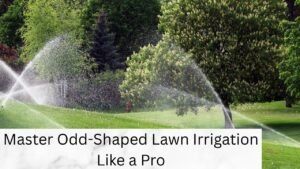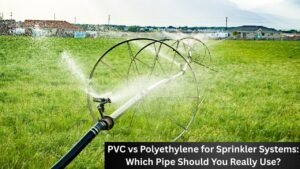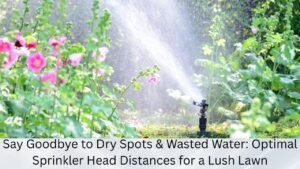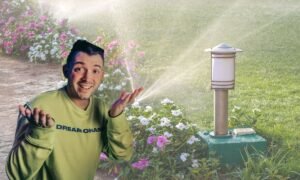
Why Most Sloped Yard Irrigation Fails — And How You’ll Fix It
Many slopes waste water, erode soil, and leave hair-trigger dry or soggy zones. That means higher water bills, dead plants up top, and fungus at the bottom.
This guide walks you through the perfect sloped yard irrigation pipe layout—step by step. Whether you’re using drip or sprinkler systems, you’ll learn how to stop runoff, balance pressure, and zone smart. You’re in the right place to make sloped watering work.
What Causes Irrigation Problems on Slopes?
Principle of Hydrology on Slopes
Gravity changes pressure. As water climbs, you lose about 0.433 PSI per foot of elevation gain. Going downhill gives you extra pressure. That imbalance can break zones, bust emitters, or flood the base.
To fix this, you’ll need pressure regulation, proper zoning, and the right pipe size (more on that in our Sprinkler Pipe Sizing Guide).
What Makes Sloped Yards So Tricky?
- Runoff & soil loss: Water racing downhill erodes soil, washing away nutrients. You can lose 30‑50% of water before plants even absorb it.
- Uneven watering: The top gets dry, the bottom stays wet—leading to parched grass above and disease‑prone ground below.
- Pressure difference: Upper emitters starve from low PSI. Lower ones drown plants with too much.
- Soil variation: Clay on top holds water poorly; sand below drains too fast. On slopes, it matters even more.
How To Prepare Before You Design — Actionable Planning
Measure Your Slope Gradient
Use a long straight edge, level, or inclinometer app. A 10° slope equals about 18% grade. Even mild slopes call for careful design.
Steeper slopes need more pressure-compensating emitters and careful pipe selection. Learn how many heads per pipe in our Sprinkler Head Calculation Guide.
Test Your Soil Type
Try the jar test: ⅓ soil in water, shake, and note layers.
Try the ribbon test: wet soil, roll it into a ribbon. Clay ribbons well; sand crumbles. That tells you infiltration and water retention.
Check Your Water Pressure
Screw a pressure gauge to an outdoor faucet. The PSI tells you how many emitters or heads each zone can handle. If unsure, use this data with our Sprinkler Zone Calculator for a smart starting point.
Map Sun Exposure & Plants
Top slopes get more sun and dry fast. Bottom slopes stay shady and moist. Group similar plants into hydrozones—zones by water needs and microclimate.
Know Local Rules
Many US cities require back‑flow preventers, limit watering time or flow rate. Always check before you build.
Choosing Your Pipe Material for Slopes
| Material | Pros | Cons |
| PVC (Schedule 40) | Very durable, good for straight runs | Rigid, needs glue/curing, harder on curves |
| Polyethylene (Poly) | Flexible, follows contours, easier to work with | Can kink if bent tight, less rigid |
PVC is excellent for straight downhill mains. Poly shines in contour-following lateral lines, especially where terrain curves. Get more detail in our Sprinkler System Layout Guide.
Drip Irrigation Layouts: Ideal for Sloped Terrain
Why Drip Works Best on a Slope
It delivers water slowly, directly to roots, controlling runoff and ensuring efficiency. You get full absorption and minimal waste.
Layout Ideas by Terrain
Contour‑Following Design
Run drip tubing parallel to contour lines. Slow flow across slope, minimize soil erosion.
Ladder or Serpentine Layout
For wide slopes, lay parallel drip lines with cross‑overs. That spreads water evenly without concentrating flow.
Terraced Slopes
Give each level its own drip zone and timing. Pressure stays balanced at each elevation.
Steep, Narrow Slopes
Use a single drip line with emitters closely spaced. Best for linear plantings.
Scattered Plants
Install a mainline on the contour. Use spaghetti tubing and micro‑sprays or button emitters to reach individual plants.
Filter & Pressure Regulator Placement
Install your filter and regulator at the start of each zone. That protects drip emitters and maintains uniform flow across elevation changes.
Why Pressure-Compensating Emitters Are Non-Negotiable
These ensure every emitter flows the same GPM, regardless of pressure changes uphill or downhill. Learn how GPM and PSI impact your system.
Smart Sprinkler System Layouts for Slopes
How To Zone Sprinklers Smartly
Divide slopes into Zone 1 (top third), Zone 2 (middle), Zone 3 (bottom).
Each zone runs separately. That prevents low or high pressure problems and lets you water each microclimate correctly.
Right Sprinkler Types
- Rotor heads: Long throw, low precipitation rate—good for large open slopes.
- Spray heads: Best on smaller, uniform zones—use pressure‑compensating models.
- Bubblers: For specific trees or deep-rooted shrubs.
Use Matched Precipitation Rate (MPR) Nozzles
They ensure every head in a zone delivers water at the same rate. Prevents pooling or dry patches.
Install Anti‑Drain (Check) Valves
These keep pipes full between cycles. That stops water from forming puddles at the bottom or losing pressure.
Routing for Sprinkler Pipes
Main line runs uphill from source. Lateral lines run along contours or gently downhill. Use swing‑joints to manage head height and angles.
Scheduling Irrigation on Slopes — Cycle and Soak Method
What Is Cycle & Soak?
Instead of one long watering period, break it into shorter segments like 5 minutes on, 30 minutes off, repeated 3 times.
That gives soil time to absorb water, preventing runoff and pooling.
Preventing Erosion and Runoff—Beyond Pipe Layout
- Mulching: Thick wood-chip or bark mulch slows water flow and boosts infiltration.
- Terracing & contour planting: Creates flat planting areas and slows slope water movement.
- Soil amendments: Add compost to improve structure and water retention.
Optimizing Systems with Smart Tech
Smart Controllers
They sync with local weather forecasts to avoid watering before rain. That’s crucial on slopes to cut runoff.
Soil Moisture Sensors
Install sensors at each zone elevation. They detect true soil moisture and stop overwatering, especially in low areas.
Common Mistakes to Avoid on Sloped Yards
- Running one long watering cycle (causes runoff).
- Ignoring pressure differences by elevation.
- Using high‑flow sprinklers without zoning.
- Installing pipes straight down hill—creates pressure imbalance.
- Skipping anti‑drain valves.
- Picking the wrong pipe material—rigid PVC where poly should be used.
DIY or Call a Pro?
| Your Situation | DIY Feasible If… | Get a Pro If… |
| Gentle slope, small area | You know basic plumbing, comfortable trenching | Very steep terrain, multi-zone sprinkler plans |
| Drip system only | Flow/PSI manageable, small scale | Complex local codes, large slopes, major excavation |
If you’re planning a multi‑zone system, you’ll absolutely want to review our Sprinkler System Layout Guide to avoid future headaches.
Featured Snippet FAQs
What is cycle and soak irrigation?
Cycle and soak irrigation breaks watering into short bursts (e.g., 5 min on, 30 min off) repeated multiple times. It helps water infiltrate soil gradually and prevents runoff on slopes.
How do you prevent low-head drainage on a slope?
Install anti-drain check valves in sprinkler heads or lines. They keep water in the pipes between cycles to prevent puddling and pressure loss.
What pipe material is best for steep hillsides?
Polyethylene pipe is best for contour-following runs. Its flexibility reduces leaks and joint needs. UV-resistant poly is smart for exposed slopes.
Final Thoughts
By applying smart hydrology principles, choosing the right pipe material, zoning your design, and using cycle‑and‑soak scheduling, you can transform a slope into a thriving, water‑efficient landscape.
Take control of your hillside today—design your slope‑optimized irrigation system now and enjoy lush, erosion‑free gardens.





